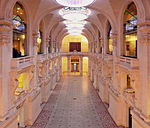Rohan bombing
1900s in Paris1905 crimes in Europe1905 in France20th-century terrorist incidents in FranceAnarchism in France ... and 8 more
Explosions in 1905Failed assassination attempts in FranceImprovised explosive device bombings in ParisMay 1905 in EuropePropaganda of the deedTerrorist incidents by unknown perpetratorsTerrorist incidents in the 1900sUnsolved crimes in France

The Rohan bombing, sometimes referred to as the Louvre attack, was an anarchist attack that occurred on 31 May 1905, at the intersection of Rue de Rohan and Rue de Rivoli in Paris. It targeted the King of Spain, Alfonso XIII and French President Émile Loubet. It killed nobody while injuring twenty-one. Presumably organized by Catalan anarchists, the police arrested four suspects following the attack. The suspects had no real connection to the bombing, apart from being left-wing or anarchist, and all were acquitted. The main suspect, a certain Aviño, known to French police as Alexandre Farras, remained at large and was never taken.
Excerpt from the Wikipedia article Rohan bombing (License: CC BY-SA 3.0, Authors, Images).Rohan bombing
Rue de Rivoli, Paris 1st Arrondissement (Paris)
Geographical coordinates (GPS) Address Nearby Places Show on map
Geographical coordinates (GPS)
| Latitude | Longitude |
|---|---|
| N 48.862777777778 ° | E 2.3352777777778 ° |
Address
Rue de Rivoli
Rue de Rivoli
75001 Paris, 1st Arrondissement (Paris)
France
Open on Google Maps











